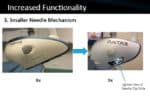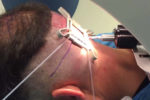
Q: I had a hair restoration procedure and the hair grew, but after one year the hair was kinky and dry. It has remained like this ever since.
From what I have read Dr Bernstein says this is uncommon but can happen. I understand there is no definitive explanation for this but I would like Dr Bernstein’s opinion on why this happens. My theory is that DHT is more prominent on the top of the head and is changing the structure of the transplanted hair. The hair is so dry and unmanageable it looks like I am wearing a wig. I await his response. — P.O., Greenwich, CT
A: Some dryness and texture changes can occur after a hair transplant and this usually self-corrects over 1-2 years during which time the transplanted hair gradually regains its original luster and texture. These changes are most likely due to the unavoidable trauma that takes place as follicles are removed from the scalp and placed into recipient sites. Excessive dryness can occur if the sebaceous glands had been stripped away from the graft. In FUT, this can be due to over dissection (i.e., grafts that are trimmed too much). In FUE, this can be due to loss or damage to the sebaceous glands in the extraction process. Persistent kinkiness may represent either damage to grafts from the procedure (improper handling, crush injury) or effects of scarring in the recipient area (usually from older procedures which used larger recipient sites) that distort the growth of follicles.
Synopsis: With the latest version of the ARTAS platform, 9x, Restoration Robotics has designed a faster and more accurate system for hair transplantation. The improved accuracy of harvesting and shortened procedure time increases graft viability, while smaller needles reduce scarring and allow patients to wear shorter hairstyles. Many of the changes in this upgrade have been made as a response to specific physician feedback.
Synopsis: Since the publication of “What’s New in Robotic Hair Transplantation” (Hair Transplant Forum Int’l. 2017; 27(3):100-101), there have been important improvements to the robotic system in both its incision and recipient site creation capabilities. These advances fall into four overlapping categories:increased speed, increased accuracy, increased functionality, and improved artificial intelligence (AI). The overlap occurs since improvements in functionality, accuracy, and AI can also increase the overall speed of the procedure. A faster procedure decreases the time grafts are outside the body and allows the physician to perform larger cases without placing additional oxidative stress on the follicles.
Synopsis:There has been a change in the nomenclature of the FUE procedure. It will not be called Follicular Unit Excision, describing the two main components of an FUE procedure, incision (separatioin of the follicle from the tissue) and extraction (the removal of the follicular unit from the scalp once it is separated). Drs. Robert M. Bernstein and William R. Rassman’s commentary explains the importance of this change in terminology.
Q: Can anyone tell me why Dr. Bernstein is still bald? — N.H., Brooklyn, NY
When Dr. Bernstein was younger and started to lose his hair, it really didn’t bother him. After medical school, he began his career as a dermatologist and became aware of surgical hair restoration. It was then when he realized that he would not be a good candidate for a hair transplant procedure, even if he wanted one, because his donor area is very thin. In the years since, he has gotten used to being bald. But his not being a candidate made him keenly aware of who is and who is not a good candidate for surgery, and this insight has helped earn him a reputation as an honest and ethical practitioner of hair transplantation.
There has been a lot of news recently circulating the web about a new way to help you grow your hair back; eating McDonald’s French fries. This theory is based on the findings of Professor, Junji Fukada of Yokohama University in Japan. Fukada and his team of researchers have studied the form of silicone called “dimethylpolysiloxane” that is used in frying oil at McDonalds to reduce frothing. Read more!









